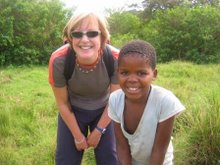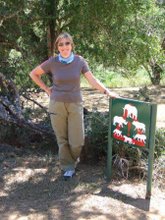We set off to explore the 11 rock hewn churches and associated tunnels, moats, channels and the carved "River Jordan" in bright sunshine and in the company of a Kidane, our guide. This place was stupendous, and should be as well known as the pyramids of Egypt.
King Lalibela came back to Roha (the town was subsequently renamed in his honour) from a 25 year exile in Jerusalem in 1185 and claimed the throne from his half brother. He then set about fulfilling his destiny of building a new Jerusalem in Ethiopia. It had become dangerous for Ethiopian Christians to make the pilgrimage there as the city had been wrested from the Crusaders by Saladin in 1187. Apparently the entire site of Lalibela was conceived and executed within 24 years, itself a minor miracle - though there was divine assistance in the form of angels at times, and theories abound about the involvement of the architecturally-minded Knights Templar also.
Whatever, today Lalibela is centred around these thousand-year-old churches, hewn from the volanic tuff. They are largely in two clusters, with a single stand-alone church dedicated to St George. The bed of the River Jordan is carved into the hillside, with a cluster each side of it. All the drainage systems from each complex are designed to run into the river, which tumbles down the hillside. There is a large carved rock cross on the riverbank to mark the point where Jesus was baptised by John. Water plays a major part of the Orthodox baptisimal ceremonies, specially at Timkat (Epiphany, usually early to mid-January), and in Lalibela the River is used. At other sites we have seen special baptisimal pools have been built for this purpose.
But, back to the churches - these were not stale archeological sites, but living treasures used by the local people everyday. UNESCO are working on site to build a museum and visitor centre, which seems a good idea, and have also built alternative accommodation in an attempt to encourage villagers who live on the site in traditional round mud and thatch huts to move away. I hope they don't intend reducing these vibrant places of worship to mere archeological wonders, preventing the locals from using them as churches, in the interests of "preservation" for the likes of us.
If you can, imagine a large rock hillside with trenches carved to release a huge mound of rock. This mound has then been carved into a series of buildings - each one was different, but all were aligned east/west, and served the function of an Orthodox church; they had the requisite three chambers, three doors and their individual collections of treasures, both ephemeral and as part of the structure itself. There were bas relief crosses (Maltese, Greek and Axumite mostly), Stars of David, and the seal of King Lalibela on walls and pillars; paintings of saints, martyrs and events in the life of Jesus; and no church was complete without its own ancient-looking priest, who ceremoniously showed us the hand and processional crosses and the old books. The churches were sometimes linked by long tunnels, or carved pathways and treacherous steps. There was a lot of mould here, the place is crying out for a waterblaster!
All the churches were being used as we were in a two-week fasting period, when churchgoing is more regular. Because it was fasting, mass was held in the afternoons, so we had a couple of hours in the morning, before things closed up for lunch, to see the first cluster - which included Beta Maryam (St Mary's) - beautifully carved inside and out, painted walls, incredibly designed and executed. There were obvious influences from Axum in the shape of the windows and some of the decorations, and also from Byzantine architecture. Kidane said that some of the masons may have come from India - some Hindu and Buddhist influences were also apparent.
We returned from lunch to visit the second cluster, but had to wait in a cave-like structure for mass to finish, and the crowds of white-clad faithful to reclaim their shoes and walk across the narrow bridge. They gathered to share cooked and sprouted beans, which I was also offered. This second cluster was possibly built for more secular purposes, and included a fortress-like building across the bridge, which may have combined living quarters for the King, with a separate cell for him to worship in alone. Or not. Who knows? Such mysteries and uncertainties were part of the charm of Ethiopia. We went from this church (even if they were conceived as secular buildings, the entire site is now consecrated and every building is used for worship) to the next via a several hundred metre long and very dark tunnel. "Just keep your right hand on the wall and you'll be OK," instructed Kidane. I had my torch, but was told the experience would be more memorable without it. Probably right!
The highlight of the afternoon though was visiting St George's - the only stand-alone church in Lalibela, the other 10 being part of one or other of the clusters. This church was really beautiful, especially when seen from "street level" - it was built down into the rock, but the roof carvings and perfect cross-shape were best appreciated from above. Access was via a long sloping pathway, past holes in the walls which housed the occasional hermit, and also a bunch of decaying bodies of monks from 300 years ago - skin and bones still easily seen. From the ground looking up, St George's swayed at odd angles, there didn't seem to be any right angles and the walls angled inwards from the ground up. Maybe an illusion, maybe not?? Inside, it was surprisingly small, and we were told that there wasn't room for chanting inside, and this took place in the open courtyard outside. It was lovely to spend sometime late in the afternoon sitting and looking at the church as the sun softened, wondering about it all. Apart from the physical work involved in carving out these structures, I was really amazed by the intricate design and interrelationships of all these buildings. It must have taken quite some foresight and skill to imagine it all, let alone articulate it.
Monday, 13 August 2007
Subscribe to:
Post Comments (Atom)




No comments:
Post a Comment